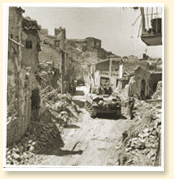

The ruins of Regalbuto: tanks of the Three Rivers Regiment in the town that was so hotly disputed in August 1943.
Canadian Military Photograph |
The Sicilian and Italian Campaigns, 1943-1945
At the Casablanca Conference in January 1943, the Allied leaders
determined that, after they had gained all of North Africa, the next
operation would be in the Mediterranean. The aim was to force Italy
out of the war.
As the first step, on July 10, 1943, American and British armies
landed in Sicily. On the left flank of the British were 1st Canadian
Infantry and 1st Canadian Army Tank . Flotillas
of landing craft supported the troops. Three Canadian bomber
squadrons operated temporarily from bases in Tunisia to support the
ground troops in Sicily and later in Italy. No. 417 Squadron, RCAF,
flew its Spitfire fighter aircraft from the first to last of the
Italian campaign.
The Allied armies occupied all of Sicily in a month. Most of the
Italian garrison troops surrendered quickly, but three German
motorized fought skilful delaying actions.
On July 25, 1943, an Italian coup drove Mussolini from power. Italy
surrendered unconditionally, but the Germans took control of the
whole country.
In September 1943, two Allied armies landed in southern mainland
Italy. Over the next year and a half, the Germans formed a number of
defensive lines across the peninsula which the were only able
to capture at considerable cost. The Canadians were involved in
terrible fighting around Ortona, on the Adriatic coast, in December
1943. About the same time, the Canadian government sent out the 5th
Canadian Armoured and the headquarters of 1st Canadian
to Italy.
The entered Rome on June 4, 1944, but the D-Day landings in
France two days later made Italy seem so much less important. The
Canadians played a leading part in the breaking of the Gothic Line
crossing the Peninsula north of Florence in August 1944. In January
1945, they were recalled to join First Canadian in North West
Europe. In all, 92,757 Canadian soldiers served in the Italian
and a quarter of these became casualties. 5,764 lost their
lives.
Related Newspaper Articles
English Articles
- Landing Fairly Easy for Canadian Invaders ; Losses Reported
Low
The Globe and Mail, 12/07/1943
- Veteran Canadian Seamen Numbering 500 Took Part in Attack Against
Sicily
The Hamilton Spectator, 14/07/1943
- RCAF Fighter Squadron on Sicily's Front Line
The Globe and Mail, 21/07/1943
- Sicily Battle Comes to End After 38 Days
The Globe and Mail, 18/08/1943
- North and Central Italy Occupied by Nazi Troops Says Hitler's
Spokesman
The Hamilton Spectator, 09/09/1943
- Canada Now Has Corps Under Own Command for Offensive in Italy
The Globe and Mail, 18/08/1943
- Victoria Cross is Awarded Major Paul Triquet, Montreal, for
Heroic Action in Italy
The Hamilton Spectator, 06/03/1944
- Perth Regiment Has Weary Task Chasing Boches
The Hamilton Spectator, 21/07/1944
- Year for Canucks in Italy Was One of Tough Fighting
The Hamilton Spectator, 29/12/1944
- Perfect Shroud of Secrecy as Canucks Moved to West
The Hamilton Spectator, 23/04/1945
French Articles
-
Sévère avertissement de M. Churchill à l'Italie
Le Devoir, 26/05/1943
-
Attaques sur la Sicile
Le Devoir, 14/06/1943
-
La Sicile désignée aux nouveaux assaults alliés
Le Devoir, 15/06/1943
-
Débarquement anglais à Termoli sur l'Adriatique
Le Devoir, 04/10/1943
-
En Italie
Le Devoir, 06/10/1943
-
La résistance allemande se raffermit en Italie
Le Devoir, 07/10/1943
-
Les Canadiens-français en tête de l'invasion de l'Italie
Le Devoir, 11/10/1943
-
L'ingéniosité des Canadiens en Italie
Le Devoir, 17/11/1943
-
Le Régiment des Trois-Rivières a plusieurs victoires à son crédit
Le Devoir, 22/08/1944
-
La campagne d'Italie
Le Devoir, 05/09/1944
-
Brillant fait d'armes des nôtres en Italie
Le Devoir, 15/09/1944
-
La 8e armée à l'attaque de la ligne gothique en Italie
Le Devoir, 16/09/1944
-
La bataille fait rage sur le front d'Italie
Le Devoir, 19/09/1944
-
Les Canadiens ont avancé en Italie
Le Devoir, 24/10/1944
-
Ravenne est aux mains des Alliés
Le Devoir, 05/12/1944
-
La campagne d'Italie
Le Devoir, 10/04/1945
-
L'armée allemande en déroute sur le front italien
Le Devoir, 23/04/1945
-
Les troupes alliés s'approchent des Alpes
Le Devoir, 26/04/1945
-
Le départ des Canadiens de l'Italie
Le Devoir, 30/04/1945
-
La bataille d'Italie est terminée
Le Devoir, 01/05/1945
|